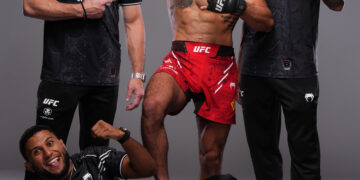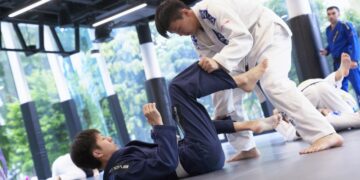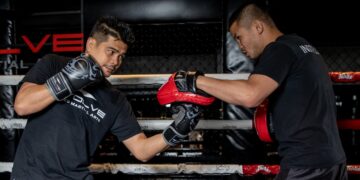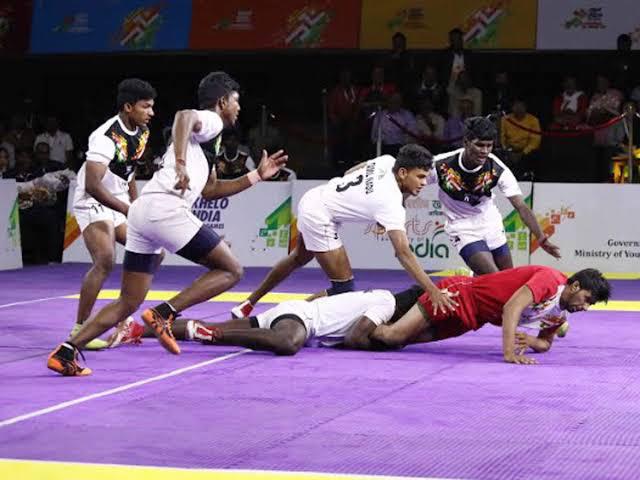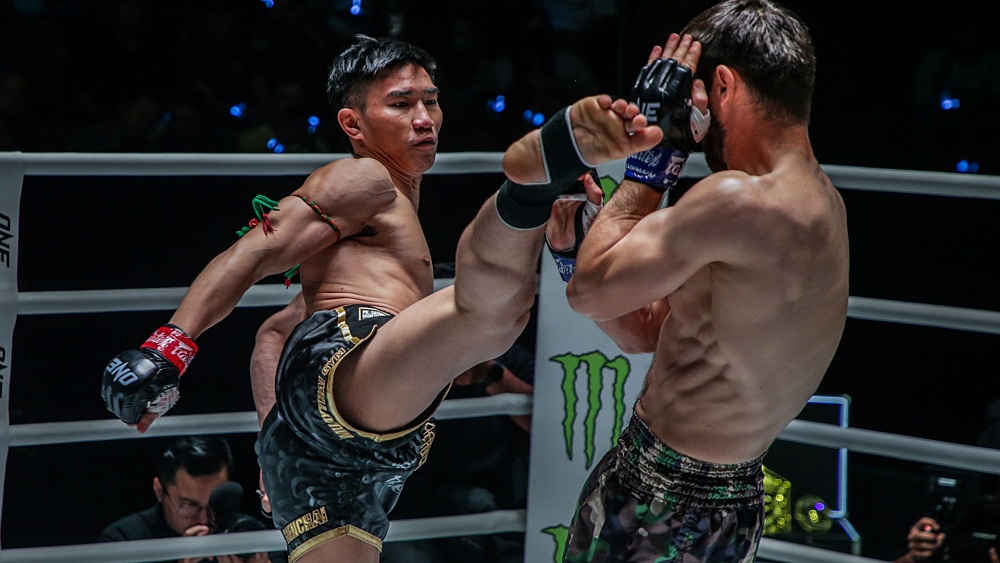
When training Muay Thai, increasing your kicking power comes down to two aspects – your technique and your physical ability. Many Nak Muays focus heavily on technique, and rightfully so, but often forget to pay the same attention to physical ability. Luckily, kicking power can be developed with no equipment at all!
Conditioning
Before we go into bodyweight exercises to increase your kicking power, it is essential to first understand the importance of shin conditioning. Imagine your shin as a baseball bat – the denser the wood, the more damage you can do.
Conditioned shins also let you use less power to do the same amount of damage. This is how fighters like Alex Pereira cause damage with what looks like a very light kick.
The first way to condition is through running. Many Thai gyms require you to run 5 miles before even starting training. This helps to build not only your cardio but also to increase bone density and endurance in the legs.
The heavy bag is the most commonly tried and tested method for conditioning your legs. You want to start very lightly, focusing on the point of impact, form, and balance. Once you are comfortable with that level of intensity, slowly up your power, maintaining a clean technique. The goal is to get thousands of reps to ingrain the movement into your body. Through this, your shins will naturally get used to taking impact.
Arm Swing
Besides the physical attributes, the right technique is also essential for developing a powerful kick. One often overlooked detail in kicking techniques is the arm swing.
The arm swing refers to what the same side arm does while you kick. To truly maximize your power, you must swing your arm in conjunction with your kick. Doing this allows your full weight to shift into the kick.
This works because of the inherent link between your shoulders and hips. Try using the arm swing next time you are on the heavy bag – it will one hundred percent increase your power! Above is a video by Shane Fazen of Fight Tips explaining and demonstrating this concept.
With these understandings, here are five bodyweight exercises you can do to increase your kicking power for Muay Thai.
1) Hindu Squat
The Hindu Squat is a type of squat that is done in a continuous motion with your knees passing over your toes. This movement is highly effective at strengthening the tendons and ligaments in your legs, an often overlooked aspect of strength.
From a standing position, row your arms backward and extend them behind you as you fall into your squat. You should go from standing on your heels to just the balls of your feet. As you stand back up, keep your arms extended, but move them upwards in front of you. The entire motion resembles the mechanics of a broad jump. Below is a video by The Bioneer that explains the Hindu Squat in depth.
The Hindu Squat helps you feel the connection between your shoulder and hips, allowing for better proprioception. You use the momentum generated from your arms to keep your momentum.
The breathing pattern for Hindu Squats is to exhale on the way down, then inhale when standing up.
This is the opposite of traditional methods of breathing, which would encourage breathing out as you stand up, bracing your core.
Inhaling as you stand during the Hindu Squat allows you to fill and expand your lungs fully, circulating oxygen and blood throughout your body.
2) Calf Raises
Your calves are an integral part of your overall kicking ability. Strong calves help stabilize your balance as you kick, an important aspect when it comes to kicking power.
Strong calves also aid in the initial explosive movement of the kick. Being quick and explosive at the start of your kick gives it a better chance for it to land and also adds power. Since the leg is already the heaviest limb, focusing on quickness and explosiveness is an effective way to maximize your kicking power.
3) Jumping Squats
Jumping squats are an advanced exercise that can dramatically increase your kicking power. Train a variety of variations to target the different muscles and ligaments in your legs.
Remember to explode through your entire posterior chain, including your calves, hamstrings, and glutes.
For those looking to take this exercise up a notch, add a front or roundhouse kick at the top of your jump. This will greatly increase the effectiveness of this exercise in terms of kicking power.
4) Single Leg RDLs
Single-leg RDLs, short for Romanian Deadlifts, translate directly to improving your kicking power and hip mobility.
This exercise is especially useful if you have trouble feeling your glutes during a power kick.
Isolating each leg gives you a chance to correct any imbalances and trains single-leg strength. This is especially important as every kick is delivered from a position of standing on one leg.
As you can see, the single-leg RDL places a strong emphasis on hip hinging, a critical movement pattern for any combat athlete.
Improving your ability to hinge at the hip will not only increase your kicking power but also enhance your overall flexibility and mobility!
5) Tactical Pull-Up
The tactical pull-up, coined by Pavel Tsatsouline, is a perfect exercise for any fighter to incorporate into their routine.
The tactical pull-up starts from a dead hang position, using pure strength and no momentum from kipping. It is also recommended to hold a hollow body position during a tactical pull-up.
The tactical pull-up develops your shoulder and lat strength while teaching you to brace your core during a strength-based movement.
This translates directly to kicking power, as your shoulders play an integral role in kicking. Many prolific kickers naturally brace their abdomen in a hollow body position while kicking, which adds to their power while keeping their internal organs safe from a potential counter.
You may also like:
An Updated Guide To The Muay Thai Scoring Systems Of Today
Muay Thai is the national sport of Thailand and, until recently, the way a fight was scored was dictated by the elite Thai stadiums. It was a nuanced system, somewhat influenced by elements of chance…
Sweeps are some of the highest-scoring techniques in Muay Thai. Knocking an opponent’s legs out from under them and sending them crashing to the canvas requires exceptional timing and skill. The mere sight of you…
Fans of ONE Championship’s Friday Fights at Lumpinee Stadium will be familiar with the name Nabil Anane. Standing at 192 cm, the Thai-Algerian is not only one of the tallest fighters in the ONE arena…
In Muay Thai, laying traps can be risky business. Even with all the right skill, technique, and planning, they are still a gamble; can you subversively impose your will on your opponent? Will you be…
In Muay Thai, Muay Mat is an aggressive and powerful breed of Nak Muay who specialize in delivering powerful punches to inflict damage on their opponents. As punches are a conditionally scoring technique under the…
The lead switch kick is a highly versatile technique that fighters can utilize across multiple combat sports such as Muay Thai and Mixed Martial Arts. The lead switch kick is often your closest weapon to…
If you’re often at KINEX Mall for a good ol’ round of boxing, Muay Thai, Brazilian Jiu-Jitsu, or mixed martial arts session at Evolve MMA, you might be wondering whether there are lovely places to…
The underhook is an aspect part of grappling in BJJ. It is a hold that gives a strategic advantage by enabling strong control over an opponent and, at the same time, a good spot for…
The pawing jab won’t bring a fight to an end, but it can be an effective tool that sets up other punches that could leave your opponent unable to continue boxing. Used by legendary boxers…
Brazilian Jiu-Jitsu is a highly dynamic martial art that relies on positioning, movement, and technique. Many positions in BJJ are deemed must-learn to stay competitive on the mats. A good example of this is the…
Finding helpful information about gaining weight can be challenging since most fitness articles are geared toward people looking to lose weight. The small minority of people looking to gain weight often have to search the…
There’s more to martial arts than what we see in competitions, movies, or popular culture. The most visible parts of martial arts are only a tiny part of any combat discipline. This gap between the…








